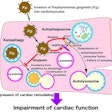
The guidelines for evaluating and treating high blood pressure have been updated for the first time in more than a decade. The new recommendations lower the threshold for hypertension and eliminate the prehypertension category.
 Dave Preble, DDS, JD.
Dave Preble, DDS, JD.For dentists, the changes could mean referring more patients to physicians for hypertension. It's also a signal that medicine may be catching up with dentistry, according to Dave Preble, DDS, JD, vice president of the ADA Practice Institute.
"The new guidelines lower what is considered hypertension," Dr. Preble told DrBicuspid.com. "It really seems to me that this is medicine catching up with dentistry from a prevention standpoint."
New and updated categories
The American Heart Association (AHA) and the American College of Cardiology (ACC) released the new guidelines at the 2017 AHA annual meeting in Anaheim, CA. The guidelines are based on a systematic review of dozens of studies and other research findings.
| Blood pressure categories | |||
| Category | Systolic (mmHg) | Diastolic (mmHg) | |
| Normal | Less than 120 | and | Less than 80 |
| Elevated | 120-129 | and | Less than 80 |
| Hypertension stage 1 | 130-139 | or | 80-89 |
| Hypertension stage 2 | 140+ | or | 90+ |
| Hypertension crisis | 180+ | and/or | 120+ |
Most notably, the guidelines lower what is considered high blood pressure to 130 mmHg for systolic blood pressure and 80 mmHg for diastolic blood pressure. They also eliminate the prehypertension category and add an elevated one. The guidelines also do not change what is considered a hypertension crisis, which is important for treatment planning.
"Dentists will probably be referring patients to physicians more frequently," said Dr. Preble, adding that "the hypertension crisis range is the only time blood pressure would affect dental treatment."
Under the new guidelines, almost half of the U.S. population qualifies as having high blood pressure, compared with 1 out of 3 people under the older guidelines. Younger adults are more likely to be affected by the changes than older adults, with hypertension diagnoses expected to triple for men younger than 45 and double for women younger than 45.
In addition to updating the categories, the guidelines emphasize getting accurate blood pressure readings by taking the average of two to three readings on at least two different occasions. They also stress the importance of treating hypertension with lifestyle changes, such as exercise and diet, in addition to pharmacological treatment.
Role of dentists in hypertension management
Hypertension treatment and monitoring largely fall under the domains of physicians, and, perhaps unsurprisingly, dentistry and oral health were left out of the almost 200-page document outlining the guidelines for the detection, prevention, management, and treatment of high blood pressure. This is despite new evidence linking periodontal disease to hypertension and heart disease, including with research from the AHA.
Nevertheless, dentists are an important part of a patient's care team, and Dr. Preble thinks that the new guidelines are an opportunity to augment the conversation about high blood pressure with patients.
"There is a natural synergy between the nutrition and lifestyle parameters that go into oral health and overall health," he said. "There is an opportunity for dentists to expand their education to patients."


















